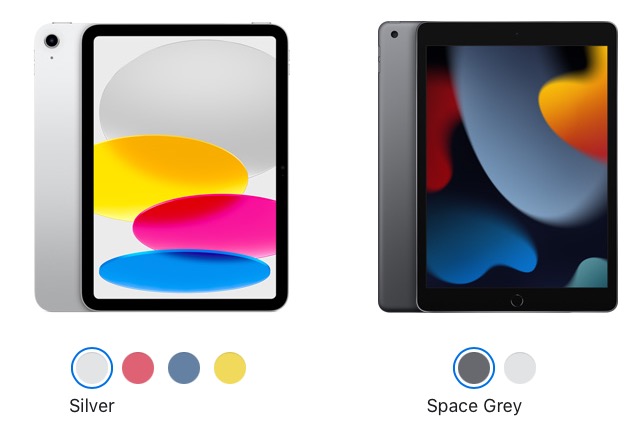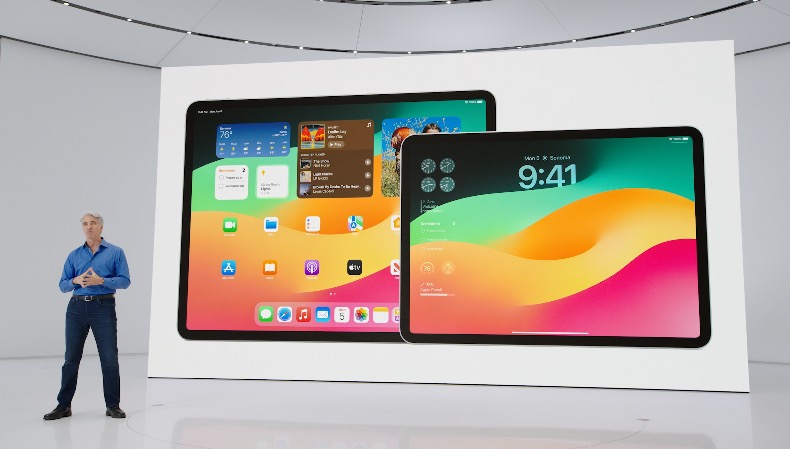
M1 iPad Air vs M1 iPad Pro (11-inch): What are the Differences?

Image: Apple
At Tuesday’s ‘Peek Performance’ event, Apple unveiled the 5th-generation iPad Air — a direct successor to the iPad Air 4 from 2020 that ditches Apple’s A-series iPhone chips for the company’s very first custom silicon for desktop — the M1.
Apple says the new iPad Air is “the most powerful and versatile iPad Air ever.” However, it is also the second iPad to come with an M1 chip under the hood, following in the footsteps of last year’s iPad Pro.
Let’s take a look at how Apple’s new M1-powered iPad Air compares against the only other (similarly sized) iPad with the same chip — the 2021 iPad Pro 11-inch…
Colours
The iPad Air 5 comes in Space Gray, Starlight, Pink, Purple, and a new shade of Blue.
The 3rd-generation iPad Air, on the other hand, is only available in Space Gray and Silver.
Display
The iPad Air features a 10.9-inch Liquid Retina display with a 2360×1640 resolution, 264 ppi pixel density, and 500 nits max brightness.
The iPad Pro one-ups the iPad Air 5 with an ever so slightly larger 11-inch Liquid Retina display with a 2360×1640 resolution, 264 ppi pixel density, 600 nits max brightness, and an adaptive 120Hz refresh rate with Apple’s ProMotion technology, which is a major difference maker.
Processor
Both iPads take a giant leap forward in processing power, foregoing Apple’s A-series iPhone chips for the desktop-grade M1 chip.
M1 equips the iPad Air 5 and 11-inch iPad Pro (3rd gen) with a powerful 8-core CPU, 8-core GPU, and next-generation 16-core Neural Engine for unrivalled performance.
The iPad Air is only available with 8GB of RAM, while the iPad Pro comes with your choice of either 8GB or 16GB, depending on your storage configuration.
Cameras
The iPad Air 5 comes with one rear shooter — a 12MP wide-angle camera, which the iPad Pro shares, but the latter also brings a 10MP Ultra Wide-angle camera and Brighter True Tone flash to the table.
Both models have a 12MP Ultra Wide-angle front camera, but the iPad Pro’s FaceTime camera is TrueDepth enabled, allowing it to shoot in Portrait mode with Depth Control and also support Animoji and Memoji.
I/O
Both iPad models sport a USB-C port, but the one on the iPad Pro also supports Thunderbolt and USB 4.
Touch ID
The 2022 iPad Air has a Touch ID sensor embedded in the Power button at the top. The iPad Pro lacks Touch ID, but it does have Face ID for secure authentication.
Audio
The iPad Air offers a two-speaker stereo setup in landscape mode, while the iPad Pro takes it a step further with a four-speaker array.
Apple Pencil Compatibility
Both models are compatible with the 2nd generation Apple Pencil. Both also support Apple’s Magic Keyboard accessory for iPads, as well as the Smart Keyboard Folio.
Networking and Battery Life
The iPad Air 5 and iPad Pro 3 support Wi-Fi 6 up to 1.2 Gbps, and both feature 5G capability.
Battery life on iPads is pretty similar, with both models managing 10 hours of video playback or web surfing on Wi-Fi, and 9 hours of web surfing on a cellular network.
Dimensions
The iPad Air 5 and 11-inch iPad Pro 3 have pretty similar physical profiles both measuring 9.74″ in height and 7.02″ in width. The new iPad Air (0.24″) is ever so slightly thicker than the 11.9-inch iPad Pro (0.23″).
Design
Both tablets feature a squared-off design aesthetic. While both iPad have pretty big screens and the actual screen size is nearly identical, the iPad Pro has markedly thinner bezels than the iPad Air.
Capacity
The 2022 iPad Air is only available in two internal storage configurations: 64 GB and 256 GB, available in both Wi-Fi only and Wi-Fi + Cellular variants.
The 2021 iPad Pro, on the other hand, is geared more towards professionals and thus offers a lot more choices: 128GB, 256GB, 512GB, 1TB, 2TB, available in both Wi-Fi only and Wi-Fi + Cellular variants.
Price
The iPad Air 5 (2022) starts at $749 CAD for the base model (Wi-Fi only, 64 GB).
The 11-inch iPad Pro 3, on the other hand, starts at $999 CAD for the lowest-end configuration (Wi-Fi only, 128GB), which is a lot more than the iPad Air.
iPad Air 5 vs 11-inch iPad Pro 3: Which One Should You Buy?
With the M1 chip under their hoods, both the iPad Air and iPad Pro are in a class of their own. With similar display sizes, batteries, and processing power, what differentiates the iPad Pro from the iPad Air is the better camera array, superior speakers, and RAM/storage configurations better suited for professionals.
If you’re a professional looking for a high-performance tablet to take with you on the go, the iPad Pro is what you should be looking at. If you’re looking for the revolutionary performance of the M1 on the ‘cheap’ (or just want some more colour options to choose from), the 2022 iPad Air is the iPad for you.
Both models are pretty similar in terms of the software experience they offer to users, especially since they won’t actually be able to make the most out of the sheer power of the M1 chip — at least not until Apple decides to better adapt iPadOS to desktop Apple Silicon, or bring macOS to the iPad.
You may be better off with a refurbished iPad Pro from Apple.ca, as models from 2018 are available for huge discounts, such as the 11-inch iPad Pro Wi-Fi 64GB (A12X Bionic) for $649 CAD, which is $100 cheaper than the new M1 iPad Air.
You can pre-order the new iPad Air on Apple.ca starting at 5 a.m. PST on Friday, March 11, with availability on March 18, 2022.

